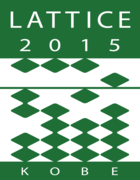Speaker
Dr
Ross Young
(University of Adelaide)
Description
By considering an appropriate modification of the action, the Feynman–Hellman (FH) theorem provides an alternative technique for studying hadron matrix elements. We report on new developments in the extension of the FH technique to the study of non-forward matrix elements, where preliminary results demonstrate the feasibility of accessing relatively large momentum transfers. In the near future, these methods offer the potential to address physics topics such as the transition to the perturbative regime in the pion form factor and the possible zero crossing in the proton’s electric form factor. We also present updated results on the extraction of the quark spin fractions in a range of hadrons, including contributions from disconnected operator insertions. At the quark masses studied, the results suggest a negative contribution to the total quark spin of the nucleon from disconnected insertions.
Primary author
Dr
Ross Young
(University of Adelaide)
Co-authors
Mr
Alexander Chambers
(University of Adelaide)
Dr
Arwed Schiller
(Leipzig University)
Prof.
Dirk Pleiter
(Julich, Forschungszentrum & Regensburg U.)
Prof.
Gerrit Schierholz
(DESY)
Dr
Hinnerk Stüben
(Universität Hamburg)
Dr
Holger Perlt
(Universität Leipzig)
Dr
James Zanotti
(University of Adelaide)
Mr
Kim Somfleth
(University of Adelaide)
Dr
Paul Rakow
(University of Liverpool)
Dr
Roger Horsley
(University of Edinburgh)
Dr
Yoshifumi Nakamura
(RIKEN AICS)

